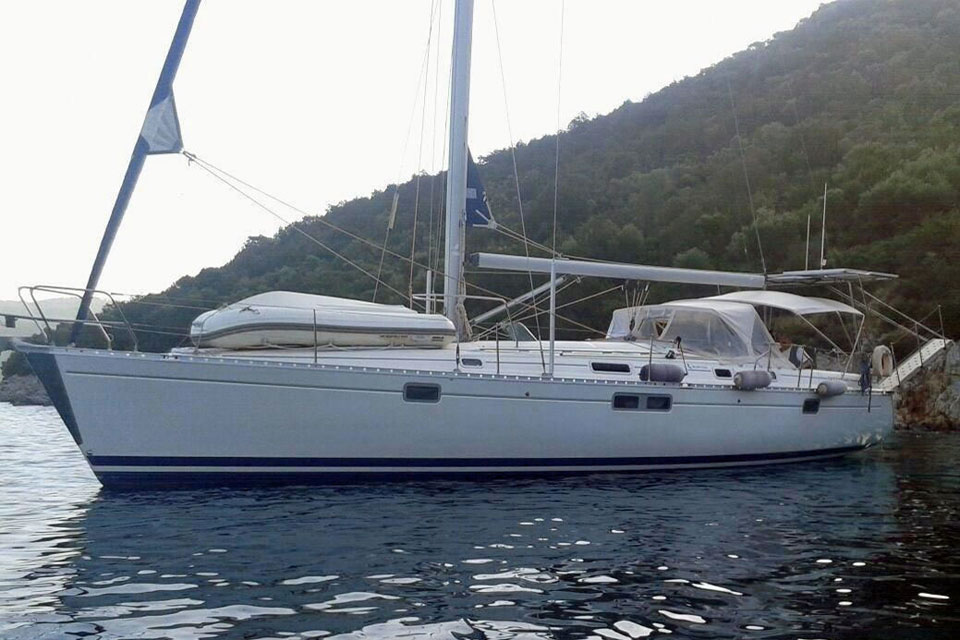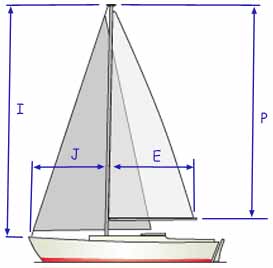- Home
- Cruising Yachts 40' to 45'
- Beneteau Oceanis 440 Specs
The Beneteau Oceanis 440
Specs & Key Performance Indicators
The Beneteau Oceanis 440 sailboat, designed by Bruce Farr, an American naval architect, was first built in 1991. Constructed by Beneteau, a French boatbuilding company headquartered in Saint-Gilles-Croix-de-Vie, France, the Oceanis 440 features a wing keel configuration and various interior layout options.
 The Beneteau Oceanis 440 was produced with either one or two double aft cabins.
The Beneteau Oceanis 440 was produced with either one or two double aft cabins.The Oceanis 440 was marketed under different names for charter companies, such as the Moorings 444/445 and Stardust 443/444. These versions had slight modifications to suit charter operations but were fundamentally based on the original Oceanis 440 design.
Published Specification for the Beneteau Oceanis 440
Keel & Rudder Configuration: Wing Keel & Spade Rudder
Hull Material: Fiberglass (GRP)
Length Overall: 13.66m (44'9")
Waterline Length: 11.58m (38'0")
Beam: 4.25m (13'11")
Draft: 1.75m (5'8")
Rig Type: Sloop
Displacement: 9,500 kilograms (20,944 pounds)
Ballast: 3,200 kilograms (7,055 pounds)
Hull Speed: Approximately 8.3 knots
Designer: Bruce Farr
Builder: Beneteau
Year First Built: 1991
Year Last Built: 1994
Number Built: Approximately 280 units
Sail Areas & Rig Dimensions
I: 16.2 meters (53.15 feet)
J: 4.6 meters (15.09 feet)
P: 14.34 meters (47.05 feet)
E: 5.2 meters (17.06 feet)
Sail Area (Main): 37.3m2 (401.4ft2)
Sail Area (Fore): 37.3m2 (401.0ft2)
Total Sail Area: 74.5m2 (802.3ft2)
Published Design Ratios
The Key Performance Indicators (KPIs)
Based on the published design ratios for the Beneteau Oceanis 440 sailboat, we can infer various theoretical sailing characteristics as follows:
- The Sail Area/Displacement (SA/D) Ratio of 17.5 indicates that the Beneteau Oceanis 440 has reasonably good performance. Boats with a ratio between 16 to 20 are considered to have good performance capabilities, balancing power and weight effectively. This means that the boat should be capable of decent speed and agility under sail.
- A Ballast/Displacement (B/D) Ratio of 34.4 is somewhat on the lower side for stiffness. Boats with a ratio of 40 or more are considered very stiff and can stand up to the wind better. However, this ratio doesn’t account for ballast positioning. Given this, the Beneteau Oceanis 440 may not be the stiffest boat, but other design aspects, such as ballast placement, could enhance its stability.
- A Displacement/Length (D/L) Ratio of 189 places the Beneteau Oceanis 440 in the Light Displacement category (100-200). This suggests that the boat requires relatively less sail area to reach its design hull speed, which can contribute to better performance and responsiveness, particularly in lighter wind conditions.
- With a Comfort Ratio of 24.2, the boat falls into the category associated with coastal cruisers with moderate stability (20-30). This implies that the Oceanis 440 offers a reasonable level of comfort for coastal cruising, with moderate pitches and rolls that would be acceptable to the average cruiser in typical coastal waters.
- A Capsize Screening Value of 2.1 is just above the threshold of 2.0, which suggests a boat is better suited for ocean passages. While the rating indicates some capability for offshore sailing, it suggests the Oceanis 440 may be more oriented towards coastal cruising rather than deep-ocean bluewater passages.
In summary, the Beneteau Oceanis 440 is a well-rounded cruiser with good performance capabilities, moderate comfort ideal for coastal cruising, and reasonable stability. However, its capsize screening value and ballast ratio suggest it may be somewhat less suited for extreme offshore conditions compared to more heavily ballasted ocean cruisers.
Here's how to calculate the KPIs yourself - without having to wrestle with the mathematics...
Design Ratios: Notes of Caution...
- The Sail Area/Displacement Ratio (SA/D): This ratio provides an estimate of the sail power relative to the boat's weight, which can indicate potential speed in various wind conditions. But it doesn't account for the efficiency of the sail plan, the rigging, or the skill of the crew. Real-world performance can vary significantly based on these factors.
- The Ballast/Displacement Ratio (B/D): This ratio gives an idea of the boat's stability and stiffness, which is crucial for handling and safety. But it doesn't consider the distribution of the ballast or the hull shape, both of which can greatly affect stability. A high B/D ratio alone doesn't guarantee a stable boat if the ballast is poorly distributed.
- The Displacement/Length Ratio (D/L): This ratio helps predict the boat's speed potential and its behaviour in different sea conditions. But it doesn't account for the hull design or the boat's overall weight distribution. Two boats with the same D/L ratio can perform very differently if their hull shapes are different.
- The Comfort Ratio (CR): This ratio estimates the boat's motion comfort in a seaway, which is important for long passages. But it doesn't consider the boat's interior layout, which can also affect comfort. Additionally, personal tolerance to motion varies, so a boat that is comfortable for one person might not be for another.
- The Capsize Screening Formula (CSF): This formula assesses the likelihood of a boat capsizing in heavy seas, which is critical for offshore safety. But it doesn't take into account the boat's handling characteristics or the skill of the crew. A boat with a low CSF can still capsize if poorly handled in severe conditions.
General Limitations
- Static Nature: These ratios are static measurements and don't account for dynamic factors like wave action, wind gusts, or crew actions.
- Simplification: They simplify complex interactions into single numbers, which can be misleading. Real-world performance is influenced by a multitude of factors that these ratios can't fully capture.
- Context: The context in which the boat is used (e.g., coastal cruising vs. offshore racing) can greatly affect how these ratios should be interpreted.
In summary, while these ratios provide valuable insights into the theoretical performance characteristics of a sailboat, they should be used as part of a broader assessment that includes practical experience, sea trials, and expert advice.
This article was written with the assistance of Gemini, a large language model developed by Google. Gemini was used to gather information, summarize research findings, and provide suggestions for the content and structure of the article.
Recent Articles
-
Is Marine SSB Still Used?
Apr 15, 25 02:05 PM
You'll find the answer to this and other marine SSB-related questions right here... -
Is An SSB Marine Radio Installation Worth Having on Your Sailboat?
Apr 14, 25 02:31 PM
SSB marine radio is expensive to buy and install, but remains the bluewater sailors' favourite means of long-range communication, and here's why -
Correct VHF Radio Procedure: Your Questions Answered
Apr 14, 25 08:37 AM
Got a question about correct VHF radio procedure? Odds are you'll find your answer here...













